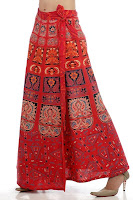 Indian Fashion, particularly said, traditional Indian fashion has touched new international heights. Karnataka's kasuti (embroidery), which is used to embellish the Kanjeevaram Sarees and Mysore Silk Sarees, will now be seen on western outfits in the boutiques of Amsterdam and London. Not only India's cherished craft of embroidery has gone global but our women- the rural women of India too have gone global with the help of their art. These western clothing with Indian touch will be designed and tailored by women of Hubli, Karnatake, India.
Indian Fashion, particularly said, traditional Indian fashion has touched new international heights. Karnataka's kasuti (embroidery), which is used to embellish the Kanjeevaram Sarees and Mysore Silk Sarees, will now be seen on western outfits in the boutiques of Amsterdam and London. Not only India's cherished craft of embroidery has gone global but our women- the rural women of India too have gone global with the help of their art. These western clothing with Indian touch will be designed and tailored by women of Hubli, Karnatake, India.
Maharashtra-based NGO Mann Deshi Foundation (MDF) has joined hands with Holland-based NGO Satara Foundation to popularize the traditional form of embroidery. Not only the foundation conducts training in tailoring and kasuti but it also trains the poor women in making hand-embroidered folders, pouches, saris, jeans, tops and newborn baby suits. Although, the main aim is to empower women, it is taking Indian fashion to the international levels through new roads. This will help the women of low income group in earning a steady income by creating international market for their products.
The Dutch volunteers from the prestigious Amsterdam Fashion Institute are training 15 women on the intricacies of western outfits. These women were earlier trained in tailoring by MDF who plans to set up a production unit in Hubli. The NGO will then export the designer clothing to the Netherlands and London. They will be marketed with the help of NGOs and fashion institutes. Now, this is called fashion with social cause!













